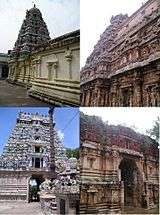Pazhayarai Vadathali
Pazhaiyarai Someswarar Temple, or Pazhaiyarai Vadathali is a Hindu temple dedicated to Someswarar, a form of Shiva. It is located 6 km away from Kumbakonam on the Kumbakonam- Aavoor road, 2 km away from the Thenupuriswarar Temple at Patteeswaram and 3 km away from Darasuram. The best mode is taking town buses from Kumbakonam or mini buses from Darasuram, the bus stop is Cholan Maligai. The Darasuram railway station is located close to the temple.
| Pazhayarai Vadathali | |
|---|---|
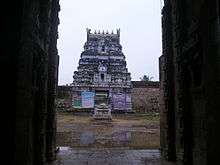 | |
| Religion | |
| Affiliation | Hinduism |
| District | Tanjore |
| Deity | Somanatha Swamy (Shiva) Somakambalambigai (Parvathi) |
| Location | |
| Location | Pazhayarai |
| State | Tamil Nadu |
| Country | India |
 Location in Tamil Nadu | |
| Geographic coordinates | 10°38′N 79°14′E |
| Architecture | |
| Type | Dravidian architecture |
The temple is believed to be built during the Chola period and has several inscriptions dating back to the 8-9th century. The presiding deity, Someswarar is revered in the 7th century Tamil Saiva canonical work, the Tevaram, written by Tamil saint poets known as the nayanars and classified as Paadal Petra Sthalam.
The temple has six daily rituals at various times from 5:30 a.m. to 8 p.m., and three yearly festivals on its calendar. The annual Brahmotsavam (prime festival) is attended by thousands of devotees from far and near.
Legend
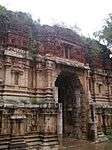
As per Hindu legend, Chandra (moon god) is believed to have worshipped Shiva in the place and Shiva appeared for him.[1][2] As per another legend, Garuda, Vishnu's eagle vehicle, carried nectar to cure his mother and was intercepted by demons. Three drops of nectar fell from his pot and they became the lingam, goddess and a holy spring. Garuda took a holy dip in the spring and won the battle. The spring is called Jadayu Theertham.[1]
History
The city of Pazhayarai was one of the capital towns of the Chola empire.[3][4][5] The temple is a part of the series of temples built by Aditya Chola (871-907 CE) along the banks of river Cauvery to commemorate his victory in the Tirupurambiyam battle. The temple is revered by the verses of the 7-8th-century saint poets Appar, Sambandar and Sundarar in Tevaram and classified as Paadal Petra Sthalam.[6] This temple is in the centre of the once famous Pazhayarai city, surrounded by Pazhayari Vadathali in the north, Araimetrali in the west and Thenthali in the south. This is the birthplace of Mangayarkarasiyar, a saint amongst the 63 nayanmars. It is one of the shrines of the Vaippu Sthalams sung by Tamil Saivite Nayanars Sambandar and Appar.[7][8][9]
The temple

The temple has a gopuram (gateway tower) in dilapidated state. The gopuram is believed to have been constructed during the later part of 12th-13th century by Later Cholas.[10] The second precinct has a two-tiered gopuram. The sanctum and the walls around the sanctum are built in granite and the structure houses the shrine of Someswarar in the form of lingam (aniconic form of Shiva). There is a shrine for his consort Someswari and the navagrahas. The scene of Ravana lifting Mount Kailash is carved in this temple. There is a sculpture of Narasimha, an avatar of Vishnu, believed to be made during the Chola period. The first of the two shows the fight between the eight-handed Narasimha and Hiranyakashipu. The other panel depicts the earlier scene where Prahlada prays and Narasimha emerges from a pillar. The other panel shows Narsimha tearing the insides of the demon thrown in his legs.[11] The image of Ardhanareeswarar is considered a sculptural masterpiece.[12]
Worship and festivals
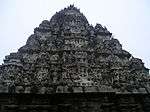
The temple priests perform the puja (rituals) during festivals and on a daily basis. Like other Shiva temples of Tamil Nadu, the priests belong to the Shaiva community, a Brahmin sub-caste. The temple rituals are performed six times a day; Ushathkalam at 5:30 a.m., Kalasanthi at 8:00 a.m., Uchikalam at 10:00 a.m., Sayarakshai at 5:00 p.m., Irandamkalam at 7:00 p.m. and Ardha Jamam at 8:00 p.m. Each ritual comprises four steps: abhisheka (sacred bath), alangaram (decoration), naivethanam (food offering) and deepa aradanai (waving of lamps) for both Someswarar and Amman. The worship is held amidst religious instructions in the Vedas (sacred texts) read by priests and prostration by worshippers in front of the temple mast. There are weekly rituals like somavaram (Monday) and sukravaram (Friday), fortnightly rituals like pradosham and monthly festivals like amavasai (new moon day), kiruthigai, pournami (full moon day) and sathurthi. The major festival of the temple, the Brahmotsavam, is celebrated during the Tamil month of Chittirai (April–May). During the same month, in the Rohini star, special poojas are performed for Mangayarkarasiyar.[1]
References
- "Someswar Temple Pazhyarai". Dinamalar. Retrieved 24 April 2013.
- Ayyar, P. V. Jagadisa (1991). South Indian shrines: illustrated. New Delhi: Asian Educational Services. p. 249. ISBN 81-206-0151-3.
- Dobbie, Aline (2006). India: The Elephant's Blessing. Melrose Press. p. 85. ISBN 9781905226856.
- Adamson, Kane (2010). A Season to Redeem. Kannan Adityan. p. 333. ISBN 9780646533735.
- Anand, Swami P.; Swami Parmeshwaranand (2004). Encyclopaedia of the Śaivism. New Delhi: Sarup & Sons. pp. 218. ISBN 81-7625-427-4.
pazhayarai.
- Census of India, Volume 7. Department of census operations. 1961.
- பு.மா.ஜெயசெந்தில்நாதன், தேவார வைப்புத்தலங்கள், வர்த்தமானன் பதிப்பகம், சென்னை, 2009
- மூவர் தேவார வைப்புத் தலங்கள், Muvar Thevara Vaippu Thalangal, பழையாறை (கீழப்பழையாறை) Pazhayarai (Keezha Pazhayarai)
- தேவார வைப்புத் தலங்கள், பழையாறை, 2-39-5, 6-13-1
- Branfoot, Crispin (2002). "'Expanding Form': The Architectural Sculpture of the South Indian Temple, ca. 1500-1700". Artibus Asiae. Artibus Asiae Publishers. 62 (2): 204. ISSN 0004-3648. JSTOR 3250266. – via JSTOR (subscription required)
- Verma, Archana (2012). Temple imagery from early medieval peninsular India. Ashgate Publishing, Ltd. p. 94. ISBN 9781409430292.
- V., Meena (1974). Temples in South India (1st ed.). Kanniyakumari: Harikumar Arts. p. 27.
Photogallery
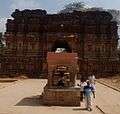 Entrance
Entrance Inner gopura seen from entrance
Inner gopura seen from entrance Balipeedam and inner gopura
Balipeedam and inner gopura Shrine of the presiding deity
Shrine of the presiding deity Shrine of the goddess
Shrine of the goddess Yagasala set up on 29 January 2016, Kumbabisegam day
Yagasala set up on 29 January 2016, Kumbabisegam day Entrance seen from the temple
Entrance seen from the temple

